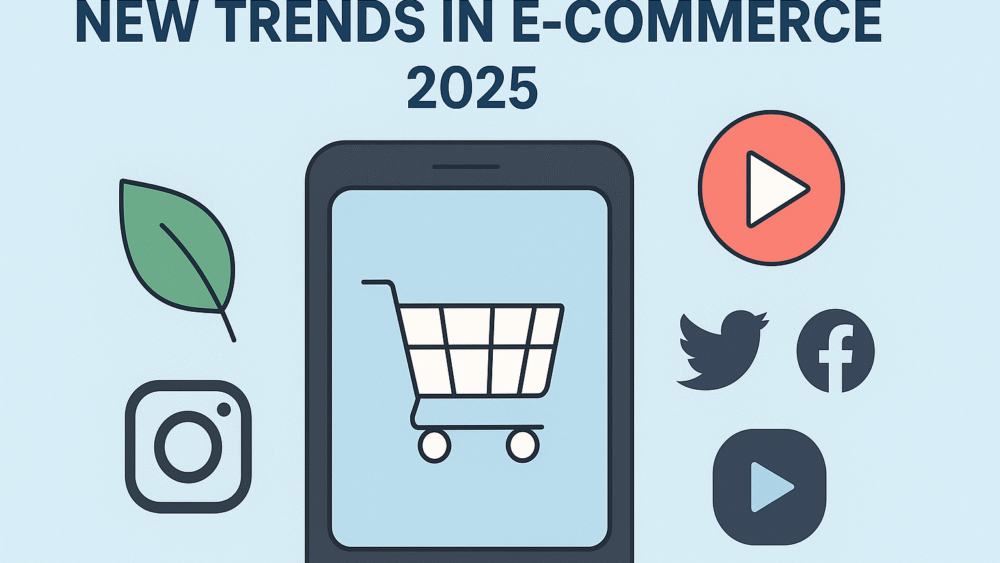E-commerce is no longer a side channel. It has become the core of the consumer experience. But the game is evolving fast: tactics that felt innovative a few years ago are already mainstream. For modern brands, simply having an online store is not enough—you need to anticipate, adapt, and innovate.
Here are six major trends shaping e-commerce in 2025:
Conscious Consumerism & Ethical Commerce
The Personalization Imperative
Mobile-First Commerce
The Rise of Social Commerce
Micro-Influencers & Authentic Partnerships
The Power of Video Content
1. Conscious Consumerism & Ethical Commerce 🌱
Shoppers increasingly ask: Who made this? How was it made? What’s the impact? Ethics, transparency, and sustainability are no longer optional—they are competitive advantages.
What it means in practice:
Fair labor practices & transparent supply chains (The Future of Commerce)
Sustainable packaging and carbon-neutral shipping (Dokan)
Circular economy models—“take-back” schemes for recycling and reuse (Green City Times)
Examples:
Patagonia publishes detailed impact reports and repair programs.
Everlane pioneered “radical transparency,” showing production costs.
H&M and Eileen Fisher run recycling programs for old clothing.
👉 According to McKinsey, more than half of consumers are willing to pay more for sustainable products (McKinsey).
2. The Personalization Imperative 🎯
Generic experiences don’t cut it anymore. Today’s consumer expects the right offer at the right time.
Forms of personalization:
AI-driven product recommendations (Salesforce)
Tailored discounts and loyalty perks
Personalized emails and push notifications
Adaptive UX layouts for different customer segments
Smart chatbots that anticipate intent
Example: A beauty brand uses AI to recommend products based on past purchases and skin type, then sends reminders when it’s time to restock.
👉 Personalization done right builds loyalty. Done wrong (too pushy or intrusive), it feels creepy. Balance is key.
3. Mobile-First Commerce 📱
Over 70% of online shopping traffic now comes from mobile devices (BigCommerce). If your mobile experience isn’t optimized, you’re losing sales.
Mobile-first essentials:
Lightning-fast, responsive websites
Simplified checkouts with digital wallets (Apple Pay, Google Pay)
App-like experiences using Progressive Web Apps (PWAs)
Vertical, mobile-native video content
Example: A fashion retailer launches a PWA that works like a native app—push notifications for offers, instant load times, and offline browsing.
4. The Rise of Social Commerce 🚀
Social media is becoming the mall of the future. Discovery, engagement, and purchase now happen in one place.
Trends & stats:
Social commerce is projected to reach $80 billion in the US by 2025 (Shopify)
Globally, the market may hit $8.5 trillion by 2030 (Hostinger)
Over 50% of marketers plan to increase investment in social selling (SproutSocial)
Practical examples:
Shoppable posts on Instagram and TikTok
Livestream shopping events (huge in Asia, rapidly spreading to the West)
In-app checkout (Facebook/Instagram Shops)
👉 Social commerce shortens the journey from discovery → conversion, making shopping almost impulsive.
5. Micro-Influencers & Authentic Partnerships 🤝
Mega-celebrities don’t hold the same trust they once did. Instead, brands are partnering with micro-influencers (1k–50k followers) who cultivate niche, highly engaged communities.
Why micro-influencers matter:
Higher engagement rates than big accounts
Lower cost, but better ROI
Authentic storytelling and behind-the-scenes content
Deeper trust with audiences
Example: A sustainable clothing brand partners with several micro-influencers who each share personal stories about wearing the products—complete with unique discount codes.
👉 According to SproutSocial, 32% of Gen Z purchase based on influencer recommendations.
6. The Power of Video Content 🎥
Video has become the most persuasive format in e-commerce. It educates, entertains, and sells at the same time.
Video formats that drive conversions:
Short-form video (TikTok, Reels, YouTube Shorts) for quick product teasers
Explainer videos to reduce returns
Shoppable videos with clickable product tags
Customer testimonial videos
Live video events with real-time offers
Example: A furniture brand posts a 30-second assembly video where each part is tagged “Tap to buy.” Conversions skyrocket compared to static product pages.
👉 Shopify notes that social + video commerce is one of the fastest-growing channels in online retail.
How to Apply These Trends (Action Plan)
Audit your current experience – mobile performance, personalization, transparency.
Show your values – publish sustainability pages, impact reports, certifications.
Invest in personalization tech – AI recommendation engines, unified data.
Optimize for mobile – ensure speed, UX, and seamless checkout.
Leverage social commerce – integrate shoppable posts and live shopping.
Partner with micro-influencers – consistent, authentic collaborations.
Make video a priority – weekly short-form and educational video content.
Track & adapt – measure conversion rates, retention, and ROI.
Final Thoughts
E-commerce in 2025 is about more than transactions. It’s about:
Trust (through ethics and transparency)
Relevance (through personalization and AI)
Presence (through mobile and social)
Storytelling (through authentic influencers and video)
Brands that master this balance will thrive in the years ahead.

